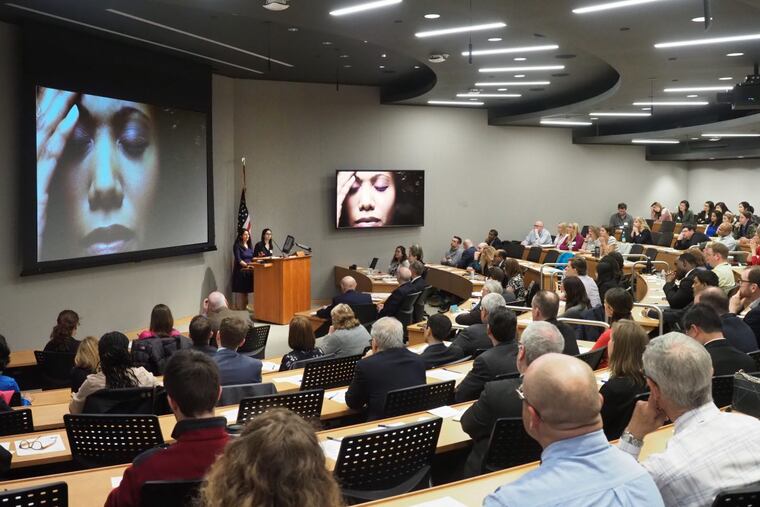Penn doctors test ideas for higher-quality, lower-cost health care
Now in its fifth year, the initiative by Penn's Center for Health Care Innovation gives doctors, nurses and others on the front line of patient care the resources to test their ideas for improving quality and reducing cost.

Can a 10-minute video visit with a doctor keep people from calling in sick to work?
Could you reduce the number of new mothers returning to the hospital with serious hypertension if you sent them home from delivery with a blood-pressure cuff?
A Penn Medicine accelerator program wants to find out.
Now in its fifth year, the initiative by Penn's Center for Health Care Innovation gives doctors, nurses, and others on the front line of patient care the resources to test their ideas for improving quality and reducing cost.
"Health care is an unusual industry in that some of the most empowered and educated people, like physicians and nurses, are right there on the front lines with the customer," said David Asch, the center's executive director. "The question is how do we harvest that highly educated population with specialized knowledge right in front of customers."
The accelerator program, sponsored by the insurer UnitedHealthcare, chose four groups from 104 applications to receive up to $10,000 to develop and test their ideas.
The four teams, as well as two graduates of the accelerator, presented their progress Monday at the Penn Medicine campus.
The groups focused on the two top charges facing American health care: improving quality and reducing cost.
While clearly a benefit to patients, there's a strong business case for why hospitals are focused on offering a better value.
Hospitals pay stiff penalties to the Centers for Medicare and Medicaid Services when patients covered by those publicly funded programs are readmitted to the hospital within 30 days of being discharged.
The accelerator's participants had a few ideas:
In a four-month pilot with 60 patients, Penn Medicine Virtual Care found that offering a five- to 12-minute video visit with a primary-care doctor improved patient satisfaction while reducing costs for doctors, employers, and insurers. Fewer patients called in sick to work or school and they avoided more costly urgent-care visits, where many patients said they would have turned had they not been able to see the doctor.
Advanced Heart Care at Home, a group of cardiovascular and palliative-care specialists, found that they could reduce hospitalizations among advanced heart-failure patients and get them palliative care more quickly by creating a personalized symptom-management program.
BreatheBetterTogether similarly found that a more personalized touch improved early intervention and reduced hospitalizations among patients with chronic obstructive pulmonary disease. The group sent daily text messages to patients and followed up with a phone call or at-home nurse visit for patients who reported feeling worse.
Supporting Older Adults at Risk flipped the traditional discharge procedure on its head: Instead of waiting to discharge patients until all at-home needs were arranged, the group sent patients home sooner and moved the assessment of their post-discharge needs to their homes. The result was less time spent in the hospital and swifter attention from at-home nurses who were able to see what each patient needed more clearly.
A common theme among the presenters was that personalized care can be an effective way to improve quality and even lower costs in the long run, by avoiding the need for more expensive treatment in the future. But these types of approaches can be expensive to execute.
Penn Medicine Virtual Care, for example, found that video calls were a cost-effective way to see patients and improve their satisfaction with the practice. But insurers pay much less for video visits, between $5 and $25, compared with about $110 for an office visit.
To succeed at a larger scale, the groups must find a way to automate what, for now, is a time-consuming labor, Asch said.
"A lot of these require a high touch," Asch said. "Can they be more automated?"
He pointed to a graduate of the innovation program as an example of a group that has scaled its initiative with technology.
Heart Safe Motherhood developed an approach to improve compliance among new mothers at risk of hypertension who are supposed to have their blood pressure checked twice in the weeks after birth. The group found that returning to the doctor's office was a barrier for women with a newborn at home, so they started sending blood-pressure cuffs home with patients and asked them to report back.
At first, one of the group's leaders served as the program's back end, capturing all the data and responding to patients. As the initiative gained traction and proved its success in reducing readmissions, the group was able to develop a more advanced technology platform that does much of the work for them.
University of Pennsylvania Health System CEO Ralph Muller said during brief remarks after the presentations that he was committed to finding ways to make these kinds of innovations part of the hospital system.
"It's not just a project," he said. "You have to really figure out how to integrate this in what we do. How do you really execute this in the long term and how do you make it stick?"